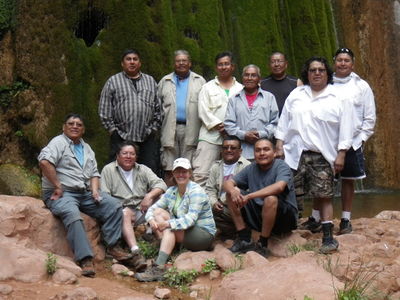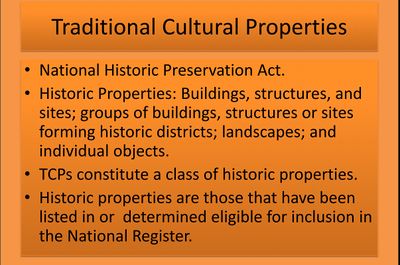|
|
| Line 185: |
Line 185: |
| | *[https://www.usbr.gov/uc/rm/amp/twg/mtgs/10nov15/Attach_01c.pdf Federal Fish and Wildlife Permit] | | *[https://www.usbr.gov/uc/rm/amp/twg/mtgs/10nov15/Attach_01c.pdf Federal Fish and Wildlife Permit] |
| | *[https://www.usbr.gov/uc/rm/amp/amwg/mtgs/10aug24/Tribal_Apology_Ltrs(2).pdf Apology Letters to GCDAMP Tribes from Ms. Castle & Mr. Walkoviak signed 9/21/10] | | *[https://www.usbr.gov/uc/rm/amp/amwg/mtgs/10aug24/Tribal_Apology_Ltrs(2).pdf Apology Letters to GCDAMP Tribes from Ms. Castle & Mr. Walkoviak signed 9/21/10] |
| − |
| |
| − | |-
| |
| − | ! <h2 style="margin:0; background:#cedff2; font-size:120%; font-weight:bold; border:1px solid #a3b0bf; text-align:left; color:#000; padding:0.2em 0.4em;">Tribal Monitoring Reports</h2>
| |
| − | |-
| |
| − | |style="color:#000;"|
| |
| − |
| |
| − | '''2016'''
| |
| − | * [[Media:ZuniColoradoRiverMonitoringTrip 2016 FinalReport 24March2017.pdf | Zuni River Monitoring Trip Report - Skyship Films ]]
| |
| − | * [[Media:2016 SPC report CLEAN COPY.docx| Southern Paiute Consortium monitoring report]]
| |
| − | * [[Media:Final River Trip Report 021217 (1).pdf| Hualapai monitoring report]]
| |
| − | * [[Media:CPO - 2016 Annual Monitoring Report.pdf| Hopi monitoring report]]
| |
| − |
| |
| − | '''2015'''
| |
| − | * [[Media:2015 SPC Annual Report Final (1).pdf |Southern Paiute Consortium monitoring report]]
| |
| − | * [[Media:Final 2015 River Trip Report 011316.pdf | Hualapai monitoring report]]
| |
| − | * [[Media:2015 Monitoring Report (1).pdf | Hopi monitoring report]]
| |
| − | * [[Media:Zuni2015ColoradoRiverMonitoringReport (2).pdf | Zuni River Monitoring Trip Report]]
| |
| − |
| |
| − | '''2014'''
| |
| − | * [[Media:2014 Navajo Nation River Monitoring Trip Report.pdf |Navajo Nation River Monitoring Trip Report]]
| |
| − | * [[Media:2014 Hopi.pdf| Hopi Long-Term Monitoring Program for the Grand Canyon]]
| |
| − | * [[Media:2014 ZUNI ASSOCIATIVE VALUES IN GRAND CANYON PROJECT.pdf|Zuni Associative Values in Grand Canyon]]
| |
| − | * [[Media:Zuni FY2014 GCDAMP Participation Annual Report (3) (1).pdf |Zuni GCDAMP Participation Annual Report]]
| |
| − |
| |
| − | '''2012'''
| |
| − | * [[Media:2012 SPC Annual Report final rev.docx| Paiute Annual Monitoring Report]]
| |
| − | * [[Media:2012 Monitoring Report.pdf | Hopi Annual Monitoring Report]]
| |
| − | * [[Media:2012 Hualapai doc.pdf | Hualapai Monitoring Report]]
| |
| − |
| |
| − | '''2011'''
| |
| − | * [[Media:2011 Zuni.pdf | Zuni Cultural Resources Monitoring Report]]
| |
| | | | |
| | |- | | |- |
|
Homelands and reservations of Native Americans associated with the Grand Canyon [1]
|
Tribal Resources
The lower reaches of Glen Canyon and the river corridor through Grand Canyon National Park, Arizona, have been used by humans for at least 13,000 years. Today, at least nine contemporary Native American Tribes claim traditional cultural ties to this area. Grand Canyon National Park contains more than 4,000 documented prehistoric and historic sites, and about 420 of these sites are located in proximity to the Colorado River. The lower reaches of Glen Canyon contain an additional 55 sites.
In addition to archaeological sites, cultural resources along the Colorado River corridor include historic structures and other types of historic properties, as well as biological and physical resources that are of traditional cultural importance to Native American peoples such as springs, unique landforms, mineral deposits, native plant concentrations, and various animal species.
Maintain the diverse values and resources of traditionally
associated Tribes along the Colorado River corridor through Glen, Marble,
and Grand Canyons.
Traditional Cultural Properties (TCPs):
• Attributes are maintained such as National Register eligibility is not compromised. These attributes will be specific to the traditionally associated peoples and will need to be identified by the federal agencies in consultation with those groups. Attributes may include aspects of location or physical integrity, as well as be intangible elements that link the resource to ongoing traditional cultural practices.
• The ability of traditionally associated people to maintain access to and use of the resources is preserved, in accordance with applicable law.
• Culturally appropriate conditions of resources are maintained based on traditional ecological knowledge; integration of the desired condition is included in relevant monitoring and management programs.
• Maintain ongoing consultation with the groups for whom the resource has traditional value. Because the desired condition of a TCP needs to be determined by the group for whom it has the traditional value, ongoing consultation is necessary to assess the condition of the resource.
• Mitigate impacts that affect the integrity of the TCPs. How and if effects can be mitigated will need to be developed in conjunction with the traditionally associated peoples for whom the resource holds value.
|



